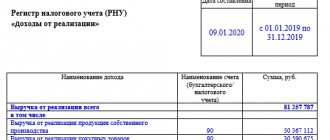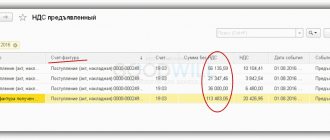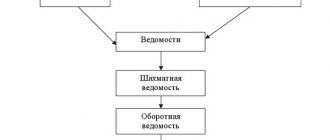Documentation is the main principle of accounting. Documents can be primary and accounting, that is, those that are created by the accountant himself and on the basis of which he prepares financial statements. Accounting registers are just such documents. This material will tell you what they are, what laws and regulations they are regulated by, and what to pay attention to when conducting them.
Novice accountants are told that a document indicator in accounting is called a register in their first year of college. After all, documents are the alpha and omega of any accounting department. All accounting registers must comply with the requirements of Article 10 of the Federal Law of December 6, 2011 No. 402-FZ, as well as the Accounting Regulations (PBU) and be prescribed in the accounting policies of the organization. The list of accounting registers used by a company depends on which accounting accounts it uses and what activities it conducts. After all, the procedure for registering, systematizing and accumulating data is directly related to the primary documents involved in the process of economic activity. First, the accounting department receives primary documents, based on the data from them, accounting registers are filled in, which, in turn, allow summary information to be reflected in the accounts. Ultimately, the data obtained is used to prepare financial statements.
What are accounting registers and why are they needed?
The activities of enterprises, especially large ones, directly depend on competent control of financial flows, as well as on monitoring the final balance of the enterprise. This is exactly what accounting does: without its work, it would be extremely difficult for enterprises of all sizes to develop.
In addition, even if the head of an enterprise would like to do without such financial self-control, according to Federal Law No. 402 of December 6, 2011, legal entities are required to send data on balance sheets, debts, etc. to the Federal Tax Service. Taken together, this means that it is simply impossible to circumvent the accounting requirement, but this is also not unnecessary bureaucratization, because self-control contributes to the growth of the enterprise.
The answer to the main question - what are accounting registers in simple words - sounds like this: it is a means of systematizing accounting data . They look like counting tables, constructed in such a way that the existing balance sheet and sources of assets and liabilities are clear.
With the help of registers, the alienation of rights to any property in the company, the movement of financial resources and other processes are taken into account. Next, all these papers are sent to the Federal Tax Service (FTS). So all data about the company, its balance sheet, open deposits and loans is registered with government agencies.
Note: accounting registers are protected by trade secrets. This is easy to understand if you consider that the accounting registers used during registration are the code for the entire official income of the enterprise, its debts, recipients of deductions, employee salaries, etc. Anyone who had acquired such data before the amendment to Russian legislation could have used it as a means to undermine competitive businesses.
Accounting registers reflect all expenses and income of the enterprise, but this can be done in different ways depending on the convenience and goals pursued by the accountant. Therefore, there is a classification of registers that allows every entrepreneur to adapt to the current business situation.
Results
The use of accounting registers is a prerequisite for every company. After all, reporting is compiled on their basis. And besides, they are needed to accumulate and systematize all important accounting information.
In commercial enterprises, forms of accounting registers are developed independently (often on the basis of already existing and frequently used once regulated forms) and approved by order of the manager. For state-owned enterprises, register forms are approved by the Ministry of Finance.
You can find more complete information on the topic in ConsultantPlus. Free trial access to the system for 2 days.
Classification of accounting registers
Depending on how the accounting department wants to structure data about the enterprise, registers are divided into:
- Systematic. This type of accounting register is intended for recording in an accounting account linked to an enterprise. This allows you to track the organization’s balance (the so-called balance sheet), overall balance, etc. An example of a systematic register is the general ledger of an enterprise;
- Chronological. The difference from the systematic type is that data is filled in in accordance with the measure of their receipt. In other words, all receipts and changes in accounting data are recorded without reference to an account, but indicating the date of the event. Example - journal, cash book, etc.;
- Synchronistic. They combine the characteristics of both previous groups: records are kept with reference to both the accounting account and the date of the event. The most common document with this type of register is a journal order.
In addition to the above types of accounting registers, maintaining a list for accounting policies is also classified according to the content and volume of records:
- Analytical. Registers of this kind allow you to systematize data according to any one characteristic (for example, sum up data on employee salaries). As a result, the manager and accounting department of the organization can analyze a specific component of the business;
- Synthetic. In this case, systematization occurs according to the principle of document homogeneity: all documents available in the organization that belong to any class of documents are accumulated in a separate group. They usually have a monetary equivalent. An example is the general ledger of an organization;
- Complex. They have characteristics of both analytical and synthetic registers and are used in most cases when filling out a journal order.
Prepare your accounting policies more carefully
Since we have already touched upon the issue of securing the registers used in the accounting policy, let’s dwell on this in more detail. Let us say right away that the Tax Code does not establish any sanctions for the fact that an organization uses registers not mentioned in the accounting policy. Likewise, there are no penalties for the fact that the accounting policy does not indicate at all which registers the organization uses and which it does not.
However, we would not advise neglecting to consolidate the list of tax accounting registers in the accounting policy. After all, this can help the taxpayer himself in the event of a conflict with the tax authorities. Thus, in the case described above, the court prohibited the request from the organization of those registers that, according to its accounting policy, should not be maintained.
Note that this is not the only case. For example, the Federal Arbitration Court of another district - Povolzhsky, considering a similar case, indicated that the taxpayer, in accordance with Articles 313 and 314 of the Tax Code of the Russian Federation, organizes it independently, reflecting it in the accounting policy. Therefore, tax authorities cannot establish mandatory forms of tax accounting documents for taxpayers, nor require those tax accounting documents that are not provided for by the Tax Code of the Russian Federation or the accounting policy of the organization itself (Resolution No. A57-17061/05-26 dated June 1, 2006).
So accounting policy is a fairly powerful weapon in a dispute with inspectors over the issue of which tax accounting registers an organization should have and which should not. True, like any weapon, it also has “recoil”. If you have already fixed the register in the accounting policy, then please ensure that it is actually maintained. Otherwise - a fine. And completely legal.
What form do registers have?
They are divided not only by appearance, but also by form of construction.
The form of construction is:
- Single-sided or double-sided. The data is filled in the journal according to the selected form (the most common is a two-sided form);
- Chess. In this case, the data is divided according to some criterion - for example, the assets and liabilities of the organization - and filled in cells at an angle to each other. As a rule, existing debits and credits are taken as separating data. Debits are plotted horizontally in the journal, and credits are plotted vertically.
In addition to the construction form, each register has a document specialized for its use. This is called the external form of the register.
- All kinds of cards. The accountant fills out certain data on a special form with a table. As of 2021, it is possible to separate account, multi-column and inventory cards - for example, a card for analytical accounting of enterprise expenses;
- Books. They look like graphed and stitched registers, usually numbering more than two hundred papers. Each page of the book is numbered and signed by the chief accountant. The most famous books in this area are the general ledger of the organization, the ledger for accounting of fixed assets, the cash book, and the registration journal;
- The so-called "free sheets" . Enlarged cards, whose functionality differs little from simple forms - a free sheet only gives a little more insight into the state of the company. Various statements are often printed on blank sheets;
- Machinegrams. The same as stated above. The difference is that these documents are compiled or printed using computers. At the moment, the number of documents filled out using technology is growing at such a rapid pace that machinograms can be approved by the Government of the Russian Federation as an outdated type of registers.
Types and forms in 2021
In 2021, business entities must maintain the following registers:
- General ledger. It systematizes the information that is reflected in the accounting accounts.
- Cash book, registration journals, which indicate data in chronological order.
- Order journals and statements are intended to systematize primary accounting data.
- Chess sheets.
- Accounting certificates.
- Transcripts for accounting accounts.
How are registers approved and filled out?
Until 2013, when amendments were introduced to Russian legislation regarding the preparation of accounting documents, all enterprises were required to record information on a unified form. Now it is permissible to use any document suitable for registration; You just need to provide the following information:
- the name of the document itself;
- legal name of the accounting company;
- time coverage of the document;
- form of registers and chosen classification order;
- an indication of all currencies and units of measurement given in the document;
- Full name and position of the person who does accounting.
The document must be approved by the person responsible for accounting (usually the chief accountant): the documentation must be signed and certified with the seal of the organization.
Please note: previously it was prohibited to make changes to the completed unified form. Now, starting in 2013, careful corrections in documentation have become acceptable.
What needs to be reflected
In 2021, business entities may not use previously approved forms of accounting registers, in accordance with the Information Regulation of the Ministry of Finance PZ No. 10/2012 dated December 4, 2012.
When forming them, you should only comply with the requirement of Federal Law No. 402 of December 6, 2011, regarding the presence of mandatory details.
When drawing up such documents, accountants must indicate the following details:
- Name (full) of the accounting register.
- Full name of the commercial organization, its code.
- The period for which this document is drawn up (or the start date of maintenance and the closing date).
- Full name of the employee who is responsible for drawing up the document.
- Signature, company seal.
This document should group data in chronological order. Systematic grouping of accounting objects can also be carried out. Units of measurement must be indicated. All data entered into accounting registers must be supported by relevant primary documentation.
It is prohibited to indicate knowingly false information that will distort the final results, due to which the organization minimizes tax liabilities to the budget. If this fact is revealed by regulatory authorities, the company and responsible persons will face financial sanctions.
Nuances of making edits
The person maintaining the accounting records of an enterprise is directly responsible for reporting false information, concealing data and distorting it. Two points simultaneously follow from this: on the one hand, the desire to correct a document should be encouraged, on the other hand, it should be punished, since this introduces confusion into control over the organization.
Therefore, correction of errors is allowed, but only if the rules are followed. If at least one of them is violated, and the form is sent along with other documents to the Federal Tax Service or other authorities, the organization will be subject to penalties.
- The first method: you can cross out the erroneous information with one straight line, and write the correct information on top, above the erroneous information. Changes must be certified here with the signature of the person responsible for the company’s accounting;
- The second method, the so-called “reversal method”: without crossing out anything, you need to write an additional entry in red ink in the window where the error was made. In this case, the changes made must also be certified by a signature;
- Next to the correction you should indicate the date the changes were made;
- When correcting, use correctors, erasers, a blade, etc. It is highly not recommended: government authorities, when reading the document, should see the originally written data;
- In addition to all of the above, a brief and meaningful explanation of such corrections must be entered in the register where the error was made. For example: “When filling out the document, data on business income was mixed up with data on business expenses for the last quarter.”
Rules of conduct
After Order of the Ministry of Finance No. PZ-10/2012 dated December 4, 2012, enterprises are not required to use unified forms, but can choose and develop their own. Until this point, accounting register data was a trade secret. The necessary details have been preserved, which should contain:
- Document's name.
- Name of company.
- Date of compilation or period of maintenance.
- Systematic or chronological classification of operations.
- In what units of measurement and in what currency are records kept.
- Responsible position.
- Signatures and full names of those responsible.
All this data is directly related to the fixed assets accounting registers.
Form
All information entered must be certified by the signature of the responsible person. If errors are found, they may be corrected. In this case, it is prohibited to use a corrector. It is enough to simply cross out the incorrect number with one line so that it remains readable, and write the correct one on top. The reversal method can also be used. To do this, you need to cross out the entire line and make a new entry with a red ballpoint pen. Corrections are made to electronic accounting registers by the person responsible for maintaining them.
For your information! Ready-made register forms are freely available; they can be found on the Internet, downloaded and printed.
Storage order
Accounting documents should be stored in dry places, protected from direct sunlight; closed shelves, cabinets and safes are ideal for this.
Storage periods are regulated mainly by Art. 29 “On accounting” and paragraphs. 8 clause 1 of article 23 of the Tax Code of the Russian Federation. The first document specifies a period of at least 5 years after the reporting year, the second - for at least four years from the date of the tax period.
Such storage periods are established by the state due to the need in certain situations to access archival documents. Often, documents are requested in connection with some kind of litigation, and not necessarily directly related to the company - it could be a lawsuit against one of its employees, for example.
It should be remembered that some registers need to be stored longer than the periods indicated above. For example, salary records must be kept for at least 75 years from the date of their registration.
Accounting in a non-profit organization
The accounting documents of NPOs, like those of commercial sector organizations, do not have standardized formats. Each economic entity independently develops the structure of accounting documentation. But Order No. 94n of the Ministry of Finance establishes the minimum number of registers an organization should have.
| Journal order number | Accounting account | Contents of operations |
| № 1 | 50 | Cash flow in the organization's cash register for the reporting period |
| № 2 | 51 | Non-cash transactions, cash flows through current accounts |
| № 3 | 55 | Transactions on special bank accounts of the company |
| № 4 | 66, 67 | Loans and credits classified by maturity (short-term and long-term) |
| No. 5 and No. 5a | 20-99 | Analytics of enterprise expenses transactions |
| № 6 | 60 | Settlements with suppliers and contractors |
| № 7 | 71 | Settlements with accountants |
| № 8 | 60, 62, 68, 72 | Settlements with customers, budget, debtors, creditors |
| № 9 | 79 | Reflection of transactions for intra-economic settlements |
| № 10 | 20, 21, 23, 25, 26, 29, 69, 70, 94, 96, 97 | Journal of expenses for the main production with a credit to the corresponding accounts (operations for experimental work, operational maintenance, personnel wages, insurance premiums and tax deductions, auxiliary production, and so on) |
| № 11 | 40, 41, 43, 45, 46, 62, 90 | Reflection of information on finished products, sales, direct sales |
| № 12 | 86 | Information about target financing |
| № 13 | 01, 02, 08 | Operations with fixed assets, depreciation, contributions to the authorized capital |
| № 14 | 14 | Information about agricultural operations |
| № 15 | 84, 98, 99 | Results of operations (profit, losses, retained earnings, losses) |
| № 16 | 07, 08 | Investments in non-current assets. Equipment intended for installation and assembly |
Download current samples of accounting document forms for 2021 in the article “We draw up a journal of business transactions”; see examples of filling out forms in the special material “How to correctly fill out a journal order”.
Accounting ledger example
One of the most common registers is the balance sheet. It is not only easy to fill out, but is also necessary for any commercial enterprise to fill out: in fact, it is this statement that reflects the current balance sheet of the enterprise, as well as its total capitalization.
Therefore, the balance sheet can be used as a sample. It looks quite simple: the content is divided into semantic blocks “How much was before accounting,” “During accounting,” and “By the end of the accounting period.” A table is compiled, divided into two subblocks under each column (the “Debit” and “Credit” blocks, the main ones in accounting).
It is not at all difficult for an experienced accountant to fill out such a table, especially in accounting. documentation, balance sheets are practically the simplest type of register. However, it does give a good initial understanding of what a register looks like and why it is needed, as well as how to fill it out.
Responsible person
Registers are part of accounting; all organizations, except individual entrepreneurs and branches of foreign companies, are required to compile them. The chief accountant must provide the head of the company with a list of all necessary information. Based on the approved list, an Order on the use of registers is issued; the information must be reflected in the accounting policies of the enterprise. The order approves the forms for each account:
- turnover balance sheet;
- account card;
- account analysis.
A person responsible for maintaining documents is appointed. According to Instruction No. 33n, all accounting registers are formed within the reporting period. If a company does not meet deadlines, this may indicate poor record keeping and weak management control.
Storage structure in the database
In order to get a general idea of the internal structure of the accounting register, first let’s look at its basic settings in the configurator. Then we will analyze the structure of the tables in the database and its connection with the register settings.
Case Settings
So, we have an accounting register with the following structure:
Let's describe each of the settings:
- Case Settings
- Chart of accounts - an indication of the “Chart of Accounts” metadata object, which is used by the accounting register.
- Correspondence – a flag indicating whether account correspondence is used when creating entries in the register. The accounting register can operate in two modes: With correspondence - in this case, a double entry mechanism is used, when each register entry contains the fields “AccountDt” (debit account) and “AccountCt” (credit account).
- No correspondence - in this case the double entry mechanism will not be used. Each record will use only one dimension to indicate the account - "Account"
- Organization – link to the “Organizations” directory. The accounting attribute is not used, i.e. the dimension will be used for all entries. The “Balance” setting is set, which determines the support for double entry for this measurement and, accordingly, the convergence of the balance for it. In other words, the accounting register in our case is configured in such a way that the balance sheet can be compiled by organization.
- Amount is a balance sheet figure used for all accounts. The subconto accounting attribute “Sum” indicates whether accounting is maintained for this resource for the subcontos specified in the invoice. We’ll talk about this in more detail and look at how this setting works using examples.
- Contents —attribute with the “String” type (max. length 150) for storing reference information of register entries.
As we can see, filling in the fields of the accounting register is mainly influenced by accounting accounts. Depending on the characteristics of account and subconto accounting, it is determined which dimensions and resources are used for recording, how the totals for accounts and subcontos should be stored, as well as other settings.
For beginners, all these settings seem confusing.
We will not go into detail about the purpose of each of the register and chart of accounts settings. You can learn about each setting from an application point of view on ITS and here . Also, in subsequent articles, we will dwell in more detail on each setting and analyze its impact on the structure of register tables and how the 1C:Enterprise platform works with them.
Register tables
In our example, we use an accounting register with correspondence support and with a maximum number of subcontos - 3. For measurements, both invoice accounting characteristics and subconto accounting characteristics are used. As a result, the platform created the following table structure:
1. Main table (_AccRg[internal number]) - the main table of the register, which stores data similar to the register structure that is specified in the configurator (dimensions + resources + details). In our example it looks like this:
Note that the values of additional Analytics, namely subcontos, are not stored in the main register table. To store them, a separate table is used, which contains all register fields, including standard ones (period, registrar, record number). There is also a Boolean “Activity” field, which affects whether the record will affect the total tables (if True, then the record is taken into account in the total tables).
2. Subconto values (_AccRgED[internal number]) - the table is created if subcontos are used for the chart of accounts of the accounting register. It is needed to store the values of subconto records of the main register table. In our example, the table has the following structure:
The “Movement type” field can contain two values: 0 - debit, 1 - credit. The subconto view in most cases contains a link to the characteristic type plan element that specifies the subconto types. The subconto value is stored according to rules similar to the data type that needs to be stored. In our case, this is a reference type (you can read more about the values of each field in this case in one of the previous articles ).
3. Summary tables. The accumulation register totals tables include:
Balance table (or account totals table) (_AccRgAT[internal number])
From the name it is already clear that the table stores the totals of account balances, by periods and in terms of dimensions of the accounting register.
For each resource, the debit and credit turnover, as well as the total turnover, are stored. When using total division for a register, the service field "Separator" is used to increase the parallelism of user work. The principle of operation of dividing totals is similar to its use in accumulation registers, so we will not go into more detail. Turnover table (or table of totals between accounts) (_AccRgCT[internal number])
The turnover table stores turnover between accounts in the context of balance sheet dimensions of the register.
As in the table of balances, debit and credit turnovers for register resources are stored and there are service fields for the mechanism for dividing totals. Subconto total tables (or totals for accounts with subconto) (_AccRgAT[number of subcontos][internal number])
Subconto totals tables store subconto totals for accounts in the context of accounting register dimensions. The tables store turnover by register resources (by debit and credit). The tables also contain fields for the total splitting mechanism.
The main feature of storing subconto totals is the use of several tables for these purposes. In our example, the chart of accounts, which is used by the accounting register, has a maximum number of subaccounts - 3. In this case, the platform creates three totals tables, where it stores the totals for 1 subaccount, 2 subaccounts and 3 subaccounts.
In subsequent articles, we will analyze in more detail how the platform works with totals and use an example to analyze changes in data in tables. The issue of the influence of the number of subcontos on the performance of accounting registers will also be considered.
4. Settings for storing totals (_AccRgOpt[internal number]) - tables with settings for totals of the accounting register. They have the following structure:
The table of settings for storing totals stores data by which the platform determines exactly how totals will be calculated for a given register, whether to use current totals and other settings. We'll talk about them in more detail later.
Note: a similar table is available for accumulation registers. When we looked at this topic earlier (back on the 8.2 platform), settings such as max. and min. There were no totals for the stored period. This is an innovation of platform 8.3. Using the accounting register as an example, we will analyze the operation of these settings, which will also be relevant for accumulation registers.
Thus, we have reviewed general information about the structure of the accounting register tables. In some respects, its internal structure is similar to the accumulation register, with the exception of tables of additional analytics - subconto, as well as tables of totals for them.







